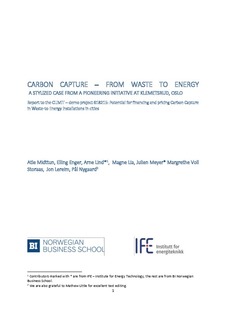Carbon capture – from waste to energy: a stylized case from a pioneering initiative at Klemetsrud, Oslo. Report to the CLIMIT – demo project 618215: Potential for financing and pricing Carbon Capture in Waste-to Energy Installations in cities
Midttun, Atle; Enger, Elling; Lind, Arne; Lia, Magne; Meyer, Julien; Storaas, Margrethe Voll; Lereim, Jon; Nygaard, Pål
Research report
Submitted version
Permanent lenke
http://hdl.handle.net/11250/2602827Utgivelsesdato
2019Metadata
Vis full innførselSamlinger
- Publikasjoner fra CRIStin - BI [1015]
- Research Reports [141]
Sammendrag
Oslo has recently been given the European Environmental Capital award for 2019, following its adoption of an ambitious green strategy of reducing CO2 emissions by 50% by 2022, and by 95% by 2030. A core premise for Oslo reaching its goals is, however, that the city’s waste to energy plant installs carbon capture for sequestration (CCS). With 400,000 tons of CO2 emissions per year (Fortum 2019), Oslo’s Klemetsrud waste to energy plant is the largest single point carbon emitter in the city, and with these emissions it will be impossible for Oslo to reach its CO2 targets. However, carbon capture at Klemetsrud also carries significance in a wider global climate perspective. Global climate models are increasingly reverting to CCS in order to arrive at scenarios that are compatible with the Paris Agreement . This has created new pressure for CCS implementation, and Klemetsrud – if successful – could be an important trigger for CCS in Europe. This report is a styilized business case study of the Klemetsrud CCS project in light of four different regulatory scenarios. Carbon capture – from waste to energy: a stylized case from a pioneering initiative at Klemetsrud, Oslo. Report to the CLIMIT – demo project 618215: Potential for financing and pricing Carbon Capture in Waste-to Energy Installations in cities
